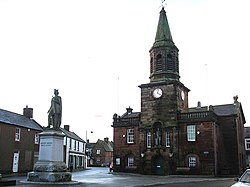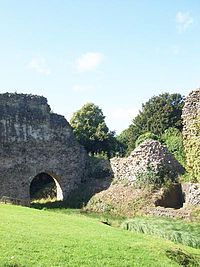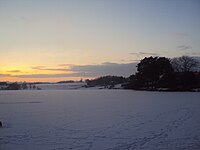Lochmaben: Difference between revisions
Created page with '{{Infobox town |name=Lochmaben |county=Dumfriesshire |picture=Lochmaben town centre.jpg |picture caption=Lochmaben town centre |population= |os grid ref=NY081824 |latitude=55.128…' |
|||
| (One intermediate revision by one other user not shown) | |||
| Line 14: | Line 14: | ||
|constituency=Dumfriesshire, Clydesdale<br/>and Tweeddale | |constituency=Dumfriesshire, Clydesdale<br/>and Tweeddale | ||
}} | }} | ||
'''Lochmaben''' is a small town in [[Dumfriesshire]], and site of a once-important castle. It lies four miles west of [[Lockerbie]]. | '''Lochmaben''' is a small town and parish in [[Dumfriesshire]], and site of a once-important castle. It lies four miles west of [[Lockerbie]]. | ||
==History== | ==History== | ||
| Line 29: | Line 29: | ||
At some point in the 13th century the Bruces built a castle, probably a keep, at Lochmaben, the remains of which now lie under a golf course. It is claimed that King Robert I of Scotland (Bruce) was born there, which is why the town adopted a Latin motto meaning "From us is born the liberator king" on its coat of arms. However this claim is relatively late, it cannot be ruled out, but his birthplace was more likely [[Turnberry Castle]]. Bruce certainly battled the English over this area during his wars. | At some point in the 13th century the Bruces built a castle, probably a keep, at Lochmaben, the remains of which now lie under a golf course. It is claimed that King Robert I of Scotland (Bruce) was born there, which is why the town adopted a Latin motto meaning "From us is born the liberator king" on its coat of arms. However this claim is relatively late, it cannot be ruled out, but his birthplace was more likely [[Turnberry Castle]]. Bruce certainly battled the English over this area during his wars. | ||
King Edward replaced the castle with a much sturdier structure at the south end of [[Castle Loch]] around 1300 and its remains still show the massive strength of its defences. Archibald Douglas, Lord of Galloway, with the assistance of the Earls of March and Douglas, after a siege of nine days, took Lochmaben Castle from the English and "razed it to the ground" on 4 February 1384/5. The castle and barony became a possession of the Earls of March, but when the 10th Earl was forfeited and then reinstated, in 1409, it is noted that it was "with the exception of the castle of Lochmaben and the Lordship of Annandale." | King Edward replaced the castle with a much sturdier structure at the south end of [[Castle Loch, Dumfriesshire|Castle Loch]] around 1300 and its remains still show the massive strength of its defences. Archibald Douglas, Lord of Galloway, with the assistance of the Earls of March and Douglas, after a siege of nine days, took Lochmaben Castle from the English and "razed it to the ground" on 4 February 1384/5. The castle and barony became a possession of the Earls of March, but when the 10th Earl was forfeited and then reinstated, in 1409, it is noted that it was "with the exception of the castle of Lochmaben and the Lordship of Annandale." | ||
The Battle of Lochmaben Fair was fought on 22 July 1484: a force of 500 light horsemen led by Alexander Stewart, Duke of Albany and James Douglas, 9th Earl of Douglas invaded Scotland, but were defeated. | The Battle of Lochmaben Fair was fought on 22 July 1484: a force of 500 light horsemen led by Alexander Stewart, Duke of Albany and James Douglas, 9th Earl of Douglas invaded Scotland, but were defeated. | ||
On 16 January 1508/9, at Edinburgh, Sir Robert Lauder of The Bass (d.1517/8), knight, was appointed "Captain and Keeper of the King's castle and fort of Lochmaben, with all pertinentes" and other privileges etc., for three years.<ref>''The Register of the Privy Seal of Scotland'' edited by M.Livingstone, I.S.O., vol.1, 1488-1529, Edinburgh, 1908, number 1799, pps: 273/274.</ref> In 1605 the Depute Lieutenant of the Borders, Sir William Cranstoun of that Ilk (later 1st Lord Cranstoun), was Keeper of Lochmaben Castle.<ref> | On 16 January 1508/9, at Edinburgh, Sir Robert Lauder of The Bass (d.1517/8), knight, was appointed "Captain and Keeper of the King's castle and fort of Lochmaben, with all pertinentes" and other privileges etc., for three years.<ref>''The Register of the Privy Seal of Scotland'' edited by M.Livingstone, I.S.O., vol.1, 1488-1529, Edinburgh, 1908, number 1799, pps: 273/274.</ref> In 1605 the Depute Lieutenant of the Borders, Sir William Cranstoun of that Ilk (later 1st Lord Cranstoun), was Keeper of Lochmaben Castle.<ref>James Balfour Paul,''The Scots' Peerage'', under 'Cranstoun' pps:592/3.</ref> | ||
Lochmaben remained important and had a turbulent history until some time after the early 17th century by which time the castle had seen its last siege and was gradually abandoned. | Lochmaben remained important and had a turbulent history until some time after the early 17th century by which time the castle had seen its last siege and was gradually abandoned. | ||
| Line 41: | Line 41: | ||
==Recreation== | ==Recreation== | ||
There is an 18-hole golf course surrounding the Kirk loch on the edge of the town. Lochmaben has three main lochs: Kirk Loch, Castle Loch and the Mill Loch.It also has two smaller lochs: The Blind Loch and the Upper Loch. The town’s lochs thrive with both sailing and fishing taking place throughout the year. In some years in winters of prolonged frost curling has taken place on the frozen lochs, most notable is the Kirk Loch. | |||
A 53 mile long-distance walking route called [[Annandale Way]] <ref>[http://annandaleway.org/ Annandale Way website]</ref> running through Annandale (from the source of the River Annan to the sea) was opened in September 2009.<ref>[http://www.ldwa.org.uk/ldp/members/show_path.php?path_name=Annandale+Way The Long Distance Walkers Association - Annandale Way]</ref> The route passes through Lochmaben and along the bank of Castle Loch. It offers interesting walking from Lochmaben on a day walk basis. | A 53 mile long-distance walking route called [[Annandale Way]] <ref>[http://annandaleway.org/ Annandale Way website]</ref> running through Annandale (from the source of the River Annan to the sea) was opened in September 2009.<ref>[http://www.ldwa.org.uk/ldp/members/show_path.php?path_name=Annandale+Way The Long Distance Walkers Association - Annandale Way]</ref> The route passes through Lochmaben and along the bank of Castle Loch. It offers interesting walking from Lochmaben on a day walk basis. | ||
Latest revision as of 22:40, 21 March 2017
| Lochmaben | |
| Dumfriesshire | |
|---|---|
 Lochmaben town centre | |
| Location | |
| Grid reference: | NY081824 |
| Location: | 55°7’41"N, 3°26’29"W |
| Data | |
| Post town: | Lockerbie |
| Postcode: | DG11 |
| Local Government | |
| Council: | Dumfries and Galloway |
| Parliamentary constituency: |
Dumfriesshire, Clydesdale and Tweeddale |
Lochmaben is a small town and parish in Dumfriesshire, and site of a once-important castle. It lies four miles west of Lockerbie.
History
Early inhabitants
The name of the village appears to be from an Old British name, "Loch of Mabon", as the Roman name of the area was Locus Maponi, according to the Ravenna Cosmography. It has been inhabited since earliest times due to its strategic position on the routes from the south across the Southern Uplands and to Ireland, to the small lochs surrounding it and to the relatively fertile soil in the area. The first inhabitants may have lived in crannogs in the lochs.
In the Dark Ages, the original Britons were joined by the English and eventually the Norse and the Norse-Gaels. Giric mac Dúngail, known in English simply as Giric and nicknamed Mac Rath ("Son of Fortune")[1] won a decisive victory at Lochmaben over the native people in 890.[2]
Lords of Annandale
By 1160, the Anglo-Norman de Brus (Bruce) family, had become the Lords of Annandale. Robert de Brus Lord of Skelton in the Cleveland area of Yorkshire, was a notable figure at the court of King Henry I of England, where he became intimate with Prince David of Scotland, that monarch's brother-in-law. When the Prince became King David I of Scotland, in 1124, Bruce obtained from him the Lordship of Annandale, and great possessions in the south of Scotland. (de Brus was nevertheless buried at Guisborough, the place of his birth). By the 15th century the Lordship was in the hands of Alexander Stewart, Duke of Albany etc., (d.1485). Following his death it, and the castle of Lochmaben, were annexed to the Crown by Act of Parliament dated 1 October 1487.[3]
Castles and battles

At some point in the 13th century the Bruces built a castle, probably a keep, at Lochmaben, the remains of which now lie under a golf course. It is claimed that King Robert I of Scotland (Bruce) was born there, which is why the town adopted a Latin motto meaning "From us is born the liberator king" on its coat of arms. However this claim is relatively late, it cannot be ruled out, but his birthplace was more likely Turnberry Castle. Bruce certainly battled the English over this area during his wars.
King Edward replaced the castle with a much sturdier structure at the south end of Castle Loch around 1300 and its remains still show the massive strength of its defences. Archibald Douglas, Lord of Galloway, with the assistance of the Earls of March and Douglas, after a siege of nine days, took Lochmaben Castle from the English and "razed it to the ground" on 4 February 1384/5. The castle and barony became a possession of the Earls of March, but when the 10th Earl was forfeited and then reinstated, in 1409, it is noted that it was "with the exception of the castle of Lochmaben and the Lordship of Annandale."
The Battle of Lochmaben Fair was fought on 22 July 1484: a force of 500 light horsemen led by Alexander Stewart, Duke of Albany and James Douglas, 9th Earl of Douglas invaded Scotland, but were defeated.
On 16 January 1508/9, at Edinburgh, Sir Robert Lauder of The Bass (d.1517/8), knight, was appointed "Captain and Keeper of the King's castle and fort of Lochmaben, with all pertinentes" and other privileges etc., for three years.[4] In 1605 the Depute Lieutenant of the Borders, Sir William Cranstoun of that Ilk (later 1st Lord Cranstoun), was Keeper of Lochmaben Castle.[5]
Lochmaben remained important and had a turbulent history until some time after the early 17th century by which time the castle had seen its last siege and was gradually abandoned.
Town
The town had prospered and become a Royal Burgh in 1447, and a Royal Charter in 1579. Its importance waned with the peace that was became the norm, but it had sufficient resources to build a substantial Tolbooth (later the Town Hall) in 1723. The town is well found with a broad main street and the town is set in rolling countryside. The railway came in 1863, with Lochmaben a stop on the Dumfries to Lockerbie line, and brought easy communication both north and south. It closed to passengers in 1952 and to freight in 1966.
Recreation
There is an 18-hole golf course surrounding the Kirk loch on the edge of the town. Lochmaben has three main lochs: Kirk Loch, Castle Loch and the Mill Loch.It also has two smaller lochs: The Blind Loch and the Upper Loch. The town’s lochs thrive with both sailing and fishing taking place throughout the year. In some years in winters of prolonged frost curling has taken place on the frozen lochs, most notable is the Kirk Loch.
A 53 mile long-distance walking route called Annandale Way [6] running through Annandale (from the source of the River Annan to the sea) was opened in September 2009.[7] The route passes through Lochmaben and along the bank of Castle Loch. It offers interesting walking from Lochmaben on a day walk basis.

See also
Outside links
| ("Wikimedia Commons" has material about Lochmaben) |
- Its page in the Gazetteer for Scotland
- A summary of Lochmaben, including accommodation and activities
- The Lochmaben and District Community Initiative website providing information about the community of Lochmaben and the surrounding district
References
- ↑ Skene, Chronicles, p. 87.
- ↑ http://www.electricscotland.com/history/dumfries/history1.htm
- ↑ Cockayne, G.E.C.,The Complete Peerage, edited by the Hon. Vicary Gibbs, vol. 1, London, 1910, p.81.
- ↑ The Register of the Privy Seal of Scotland edited by M.Livingstone, I.S.O., vol.1, 1488-1529, Edinburgh, 1908, number 1799, pps: 273/274.
- ↑ James Balfour Paul,The Scots' Peerage, under 'Cranstoun' pps:592/3.
- ↑ Annandale Way website
- ↑ The Long Distance Walkers Association - Annandale Way
- The Visitation of Yorkshire, 1563/4, by William Flower, Norroy King of Arms, and edited by Charles B. Northcliffe, M.A., of Langton, London, 1881, p. 40
- The Dormant, Abeyant, Forfeited, and Extinct Peerages of the British Empire, by Sir Bernard Burke, C.B.,LL.D., Ulster King of Arms, &c., London, 1883, p. 80.
- Scottish Kings, 1005-1626, by Sir Archibald H Dunbar, Bt., Edinburgh, 1899
